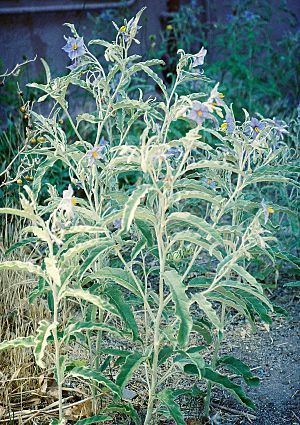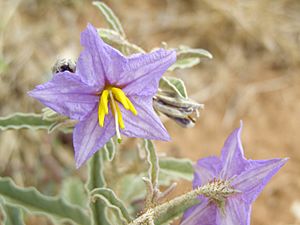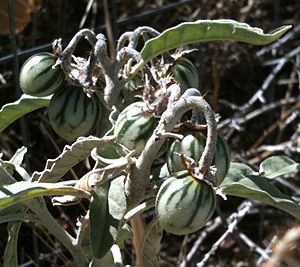Silverleaf nightshade facts for kids
Quick facts for kids Silverleaf nightshade |
|
|---|---|
 |
|
| Plant with flowers, unripe berries (green with stripes, center), and previous year's berries (orange, upper left) | |
| Scientific classification | |
| Genus: |
Solanum
|
| Species: |
elaeagnifolium
|
| Synonyms | |
|
See text |
|
Solanum elaeagnifolium, also known as the silverleaf nightshade, is a common plant. It grows naturally in parts of the southwestern United States. You can also find it in western North America and South America. Sometimes, it grows where it's not wanted, acting like a weed.
People call it by many other names too. These include prairie berry, silverleaf nettle, white horsenettle, or silver nightshade. In South Africa, it's known as silver-leaf bitter-apple or satansbos (which means "Satan's bush" in Afrikaans). In Spanish, it's sometimes called "trompillo". This plant also grows in the Middle East.
A. J. Cavanilles first described Solanum elaeagnifolium. Other botanists later used the same name for different plants.
Contents
About the Silverleaf Nightshade
What it Looks Like
The silverleaf nightshade is a perennial plant. This means it lives for more than two years. It can grow from about 10 centimeters (4 inches) to 1 meter (3 feet) tall.
Its stems have sharp, nettle-like prickles. Some plants have only a few, while others are very prickly. The leaves and stems are covered with soft, fuzzy hairs. These hairs lie flat and hide the surface. This gives the plant a shiny, silvery, or grayish look.
The leaves can be up to 15 centimeters (6 inches) long. They are usually narrow, about 0.5 to 2.5 centimeters (0.2 to 1 inch) wide. Their edges are slightly wavy. This helps tell it apart from a similar plant, the Carolina Horsenettle.
Flowers and Berries
The flowers bloom from April to August. They have five petals that join together to form a star shape. Their color can be blue, light lavender, or sometimes white. In the center, there are five yellow stamens and a pistil.
The plant also grows shiny berries. These berries can be yellow, orange, or red. They stay on the plant all winter. As they dry out, they might turn brown.
Where it Grows and Spreads
This plant grows from Kansas south to Louisiana. It also spreads west through the U.S. states bordering Mexico and into Mexico itself. You can find it in Uruguay, Argentina, and Chile too. Scientists think it might have started in North America and then traveled to South America, or the other way around.
It can grow well in poor soil and doesn't need much water. It spreads easily using rhizomes. These are underground stems that can grow new plants. It also spreads through its seeds. You often see it in places where the ground has been disturbed.
Why it Can Be a Problem
The silverleaf nightshade is considered a noxious weed in many places. This means it's a plant that causes problems, especially for farming. It's a problem in 21 U.S. states and countries like Australia, Egypt, Greece, India, Israel, Italy, South Africa, and Zimbabwe.
It is hard to control because even small pieces of its roots can grow into new plants. Also, the plant can be harmful to farm animals if they eat too much of it.
Good Uses of the Plant
Even though it can be a weed, some gardeners like it. They use it as a xeriscape ornamental. Xeriscaping is a way of gardening that uses plants that need very little water.
Historically, the Pima Native Americans used the berries. They used them like a vegetable rennet to help curdle milk. The Kiowa people used the seeds along with animal brain tissue to tan leather.
Images for kids
See also
 In Spanish: Solanum elaeagnifolium para niños
In Spanish: Solanum elaeagnifolium para niños




